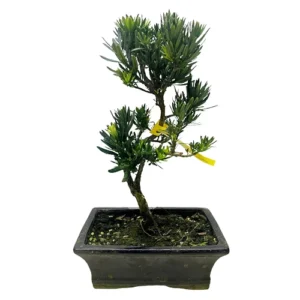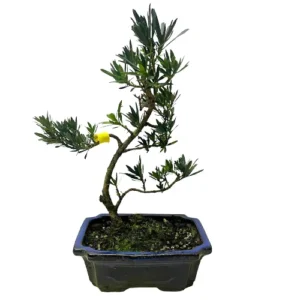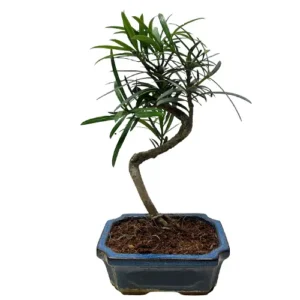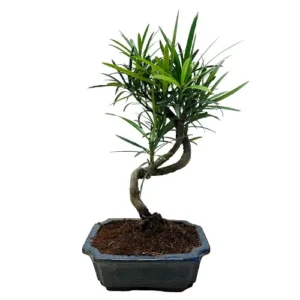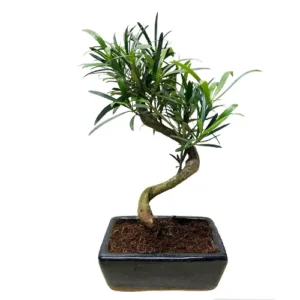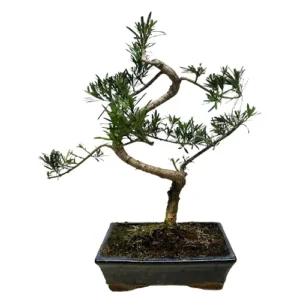Podocarpus Macrophyllus
Buddhist Pine Bonsai
The Buddhist Pine is native to tropical mountain regions in Japan and China and is usually found as an evergreen shrub. Also known as Chinese yew, it can produce berry-like blue or green fruits and has dark green needle-like foliage.

Buddhist Pine Bonsai Care Tips
Placement
The Buddhist Pine can be kept indoors all year round. However its growth and health would benefit from the extra sunlight and airflow that the summer months bring, so consider placing outside once frosts have passed.
During colder months, when temperatures drop below 7-13 °C, bring it back inside and place in a bright and cool atmosphere. 10-15 °C is a suitable temperature range if you find you are unable to provide a lot of bright light. Otherwise, temperatures around 20 °C are optimal when combined with high levels of light.
If you would prefer to keep your Buddhist Pine outdoors all year round, this is possible, but be aware that they are not a frost hardy species. Protect it from frost and the cold by using measures such as a cold frame and ensure protection from strong winds. If the needles of your tree become too elongated, take this as a sign that your pine is not receiving enough light and consider moving it to a brighter place or investing in artificial lighting.
Watering
There is no definitive guide to watering, and it should be conducted on an observational schedule, not a routine. This means that it is important to keep an eye on the moisture levels of the soil to avoid over and under watering, both which can lead to dropping leaves and/or root death. The amount of water a bonsai requires depends on pot size, climate, airflow, soil and tree type so it is best to use your eyes and fingers to assess whether the soil is damp, wet or dry.
If the top inch or so of soil has dried, it is ready to be watered. When you water, try to get an even coverage over the roots and soil, allowing water to flow out from the bottom of the pot to ensure a good soaking.
If you are a first-time bonsai owner, another way to water is by submerging the entire pot in water until the bubbles stop. If you choose this method, be aware that your bonsai may not need watering for another two to four days, but this will depend on the factors mentioned above such as soil type, pot size and climate. If you find the needles are turning greyish or loosing colour, this is a sign that the tree is being overwatered.
The Buddhist Pine also benefits from slightly higher humidity levels. This can be achieved by using a mister to spray the leaves, as well as placing a gravel tray under the pot to create a more humid microclimate around the tree.
Feeding & Fertilising
Using fertiliser on your Buddhist Pine will help encourage healthy growth and this should be done periodically from once a week to every two months and only during the growing season. You can start adding Chrysal Liquid Bonsai Feed to your water from March until October and use weekly. Use Naruko Fertiliser Slow Release Bonsai Feed once every one to two months. With Buddhist Pine trees, less is more, and we tend to advise using half the recommended dosage to see how your Buddhist Pine reacts first.
Pruning & Wiring
Regular trimming of your Buddhist Pine will help your tree grow a thicker trunk, encourage back budding and keep it miniature. Trim and pinch back new growth, which can be identified by its lighter green colour, throughout the year and whenever needed. Once the new growth is around 10cm, trim it back leaving some new foliage, but ensure that you never remove all new growth from the pine otherwise it could die.
A young Buddhist Pine can be easily wired as its branches bend very well and this can be done any time of the year. Older trees are more brittle and should be handled with care. Wire generally should be removed after 2-3 months, when it starts to bite into the bark. We further recommend using wires with a thickness that matches the thickness of the branch: if the wire you choose is too thick you will damage the bark. If it is too thin, it won’t be effective.
Repotting
Repotting your tree is an important way to provide a fresh and suitable soil mix and ensure appropriate root health. Repot in early spring. Generally, your Buddhist Pine will need to be repoted once every two years if it is young, while older ones can stay in their pots for longer. However, you should always check if it has become root-bound before you change pots. You can do this by lifting the tree gently out of the pot by the main trunk and examining the root system. You will know it is ready if you can see that the roots are circling around each other and the pot. If, however, they still appear contained in the soil, you should place it back and wait until the following spring to check again.
Trees that are ready for repotting will require root pruning, a suitable new pot and appropriate soil mix.
When repotting, do not cut back the root mass by a large amount, and choose a well-draining soil mix that has a neutral or slightly higher PH value of 5-6 but not over 7. We tend to use a mixture of different speciality bonsai soils on our trees. Every species is different so please contact us for free soil-mix advice or to take advantage of our repotting service.
Bonsai make for a one-of-a-kind indoor plant offering elegance, nature and art all in one minute form. Across an array of exquisite and erudite species, they all demand their own specific care and cultivation needs in order for their beauty to flourish. We have an extensive library of care guides for indoor bonsai trees so you can make an informed and considered choice. It’s not about selecting the perfect bonsai, it’s about selecting the perfect bonsai for you.
Buddhist Pine Bonsai - Typical Queries
How to propagate a Buddhist Pine Bonsai?
A Buddhist Pine bonsai can be propagated by seeds, cuttings, or air layering. Seeds can be sown in moist soil and kept in a warm place until they germinate. Cuttings can be taken from healthy branches and rooted in water or soil. Air layering can be done by making a small cut on the stem, wrapping it with moist sphagnum moss and plastic, and cutting it off when roots appear.
How to deal with pests and diseases on a Buddhist Pine bonsai?
A Buddhist Pine bonsai can be affected by pests and diseases such as scale insects, mealybugs, spider mites, aphids, fungal infections, and root rot. These can be prevented by keeping the plant healthy, clean, and well-ventilated. Any signs of infestation or infection should be treated promptly with insecticidal soap, neem oil, or fungicide. Severely affected parts should be pruned and disposed of.
How to style a Buddhist Pine bonsai?
A Buddhist Pine bonsai can be styled in various ways, depending on the preference and skill of the grower. Some of the common styles are formal upright, informal upright, slanting, cascade, semi-cascade, literati, forest, and raft. The style should suit the natural characteristics of the plant and enhance its beauty and elegance.
How to choose a Buddhist Pine bonsai?
A Buddhist Pine bonsai can be purchased from a reputable bonsai nursery or online store. The plant should be healthy, vigorous, and free of pests and diseases. The trunk should be thick and tapered, the branches should be well-spaced and balanced, and the foliage should be dense and green. The pot should be suitable for the size and style of the plant and have adequate drainage.
How to display a Buddhist Pine bonsai?
A Buddhist Pine bonsai can be displayed indoors or outdoors, depending on the climate and the season. It should be placed in a location that receives moderate to bright indirect light, away from direct sunlight, drafts, or heat sources. It should be rotated periodically to ensure even growth and exposure. It should be accompanied by a stand, a mat, or a tray that complements its shape and color. It should also be cleaned and groomed regularly to remove any dust, debris, or fallen leaves.

